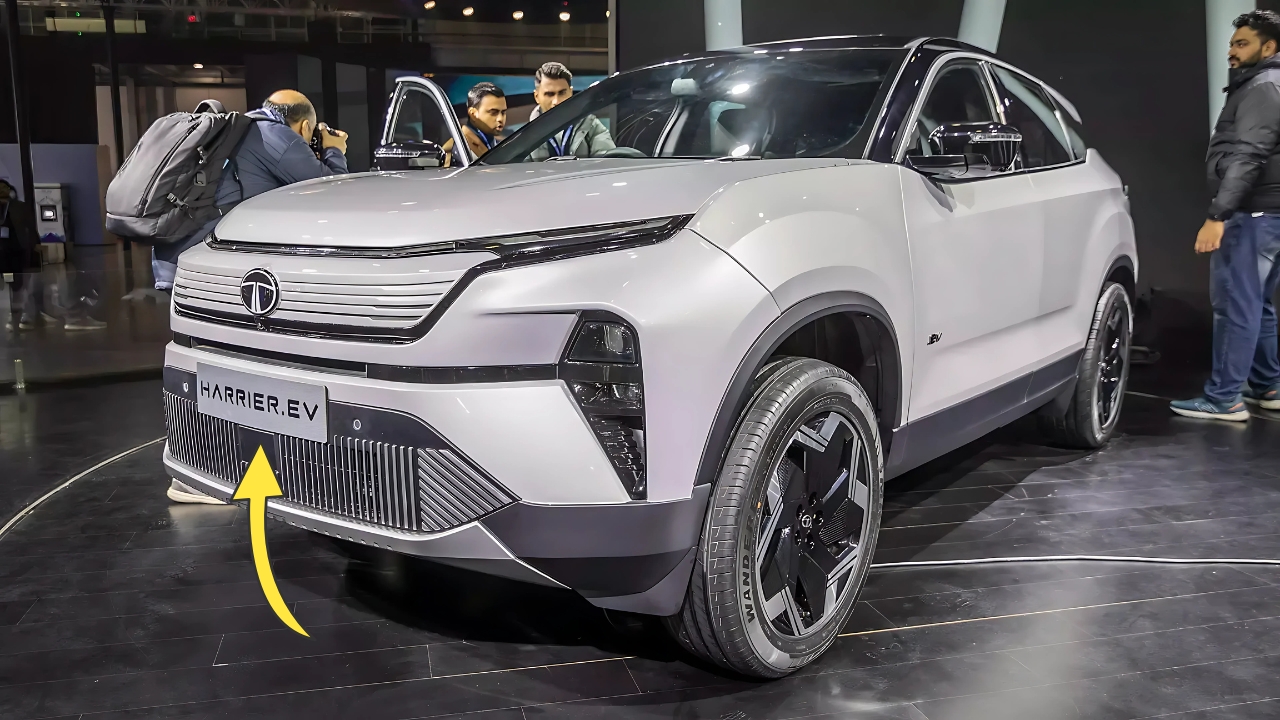Tata Harrier EV: The automotive landscape in India is undergoing a significant transformation, with electrification emerging as the definitive path forward.
Tata Motors, having established early leadership in the electric vehicle segment with models like the Nexon EV and Tiago EV, is now expanding its electric portfolio into the premium SUV space with the Harrier EV.
This ambitious offering represents Tata’s commitment to sustainable mobility across diverse market segments while building on the conventional Harrier’s established reputation.
Design Evolution: Familiar Yet Futuristic
The Harrier EV retains the commanding presence of its internal combustion counterpart while incorporating distinctive design elements that signal its electric identity.
The most notable exterior transformation occurs at the front, where the traditional grille gives way to a sleek, closed-off panel integrating advanced LED lighting elements.
This illuminated fascia creates a striking visual signature, particularly in low-light conditions, instantly distinguishing the electric variant.
The profile remains largely faithful to the original Harrier’s muscular stance, with its floating roof design and pronounced wheel arches intact.
However, aerodynamic enhancements are evident in the redesigned bumpers, side skirts, and specially developed alloy wheels that reduce turbulence while maintaining the vehicle’s rugged appeal.
These thoughtful modifications contribute to extended range without compromising the Harrier’s distinctive aesthetic character.
At the rear, connected LED tail lamps spanning the width of the vehicle create a contemporary light signature, while subtle blue accents and EV badging complete the transformation.
The overall design successfully balances continuity with innovation, allowing the Harrier EV to attract both existing Tata loyalists and new customers entering the electric vehicle market.
Platform and Architecture: Purpose-Built Electrification
Unlike many early electric offerings that adapted conventional platforms, the Harrier EV utilizes Tata’s advanced SIGMA (Scalable Intelligent Generic Modular Architecture) platform.
This dedicated EV architecture, evolved from the company’s Acti.EV platform, enables optimal packaging of battery systems, motors, and electronic components while maintaining interior spaciousness and structural integrity.
The skateboard-style architecture positions the battery pack under the floor, creating a low center of gravity that enhances driving dynamics while protecting the power source from potential road hazards.
This configuration also enables greater interior flexibility and creates a flat floor for improved passenger comfort, particularly for the middle rear seat occupant.
Advanced high-strength steel and aluminum components feature throughout the structure, optimizing the strength-to-weight ratio – a critical consideration for electric vehicles where efficiency directly impacts range.
Sophisticated crumple zones and reinforced passenger compartments maintain Tata’s commitment to safety, addressing the unique crash protection requirements of electric vehicles.
Powertrain and Performance: Balancing Power with Efficiency
The Harrier EV offers two powertrain configurations to address diverse customer requirements. The standard variant features a single motor driving the front wheels, delivering approximately 150 kW (201 hp) and 320 Nm of instantaneous torque.
This configuration prioritizes efficiency while providing performance comparable to premium diesel SUVs in this segment.
The more powerful dual-motor all-wheel-drive variant produces a combined output exceeding 220 kW (295 hp) and 500 Nm of torque, enabling impressive acceleration and enhanced capability in challenging terrain or adverse weather conditions.
The intelligent torque distribution system continuously monitors driving conditions, seamlessly adjusting power delivery between axles to optimize traction, stability, and efficiency.
Both variants feature multiple driving modes – Eco, City, and Sport – allowing drivers to prioritize range or performance based on their requirements.
Regenerative braking intensity can be adjusted through paddle shifters, enabling one-pedal driving in urban environments while maximizing energy recovery during deceleration.
Battery Technology and Charging Infrastructure
At the heart of the Harrier EV lies a high-density lithium-ion battery pack with a capacity between 60-80 kWh depending on the variant.
This energy storage system incorporates advanced thermal management to maintain optimal operating temperatures across India’s diverse climate conditions, preserving battery health and performance over extended periods.
The intelligent battery management system continuously monitors individual cell performance, optimizing charging patterns and discharge cycles to maximize longevity.
Tata claims a certified range exceeding 450 kilometers on a single charge for the standard variant, with the actual range varying based on driving conditions, climate control usage, and driving style.
Charging flexibility remains crucial for customer adoption, and the Harrier EV accommodates multiple charging options. The vehicle supports up to 150 kW DC fast charging, enabling a 10-80% charge in approximately 30 minutes at compatible stations.
Standard AC home charging through a 7.4 kW wallbox completes a full charge overnight, while compatibility with India’s growing public charging infrastructure ensures convenience during longer journeys.
Interior Experience: Sustainable Luxury
Inside, the Harrier EV blends premium aesthetics with sustainable materials and advanced technology.
Recycled fabrics, responsibly sourced wood accents, and eco-friendly alternatives to traditional leather upholstery reflect Tata’s commitment to environmental consciousness beyond the powertrain.
The dashboard centers around a floating 12.3-inch infotainment touchscreen with wireless smartphone integration, complemented by a fully digital instrument cluster of similar dimensions.
The interface incorporates EV-specific displays showing energy flow, regeneration levels, and range predictions, helping drivers optimize their journey planning.
Advanced features include a panoramic sunroof, ventilated front seats, multi-zone climate control, ambient lighting, and a premium audio system.
The absence of a transmission tunnel increases rear floor space, while the frunk (front trunk) provides additional storage capacity not available in the conventional Harrier.
The Harrier EV’s connected car technology enables remote monitoring and control through a dedicated smartphone application.
Users can precondition the cabin temperature while the vehicle remains plugged in, preserving battery range for actual driving.
Additional functions include remote charging management, location services, and predictive maintenance notifications.
Advanced Driver Assistance Systems
Safety and driver assistance receive significant emphasis in the Harrier EV, with a comprehensive suite of advanced systems.
These include adaptive cruise control, autonomous emergency braking, lane keeping assistance, blind spot monitoring, and rear cross-traffic alert.
The 360-degree camera system incorporates augmented reality elements to assist with precise maneuvering in tight spaces.
These features operate through a network of ultrasonic sensors, radar units, and cameras integrated discreetly throughout the vehicle’s exterior.
The centralized vehicle computer processes this information to provide timely alerts or interventions, enhancing safety without being intrusive during normal driving conditions.
Market Positioning and Future Implications
The Harrier EV represents a strategic move into the premium electric SUV segment, positioning Tata against international competitors while showcasing Indian engineering capabilities.
By offering sophisticated technology, compelling design, and practical usability, Tata aims to address the needs of environmentally conscious consumers unwilling to compromise on the versatility and presence of a substantial SUV.
This model also serves as a technology showcase, introducing innovations that will eventually cascade through Tata’s broader electric lineup.
The modular architecture provides a foundation for future models across different segments, accelerating the company’s electrification journey while optimizing development costs.
Tata Harrier EV:
The Tata Harrier EV emerges as a significant milestone in India’s automotive evolution, demonstrating that indigenous manufacturers can develop sophisticated electric vehicles tailored to local requirements while meeting global standards.
By combining practical range, thoughtful features, and distinctive design with Tata’s established reputation for value, the Harrier EV has the potential to accelerate electric vehicle adoption in the premium segment.
As India’s charging infrastructure continues to expand and consumer awareness of electric mobility grows, products like the Harrier EV will play a crucial role in normalizing electrification beyond urban environments.
The successful implementation of this ambitious model may well define Tata Motors’ position in the automotive landscape of the coming decade, while inspiring broader innovation throughout the Indian automotive industry.

